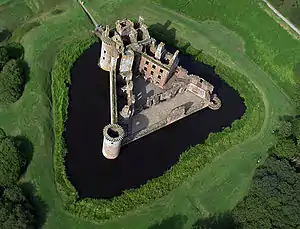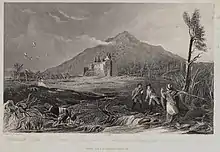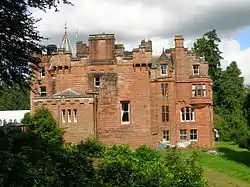Caerlaverock Castle
Caerlaverock Castle is a moated triangular castle first built in the 13th century. It is located on the southern coast of Scotland, 11 kilometres (6.8 mi) south of Dumfries, on the edge of the Caerlaverock National Nature Reserve. Caerlaverock was a stronghold of the Maxwell family from the 13th century until the 17th century, when the castle was abandoned. It was besieged by the English during the Wars of Scottish Independence, and underwent several partial demolitions and reconstructions over the 14th and 15th centuries. In the 17th century, the Maxwells were created Earls of Nithsdale, and built a new lodging within the walls, described as among "the most ambitious early classical domestic architecture in Scotland".[1] In 1640 the castle was besieged for the last time and was subsequently abandoned. Although demolished and rebuilt several times, the castle retains the distinctive triangular plan first laid out in the 13th century. Caerlaverock Castle was built to control trade in early times.[2]
| Caerlaverock Castle | |
|---|---|
| 11 kilometres (6.8 mi) south of Dumfries, Dumfries and Galloway GB grid reference NY024655 in Scotland | |
 Caerlaverock Castle from the air | |
 Caerlaverock Castle | |
| Coordinates |  54°58′32″N 3°31′26″W
54°58′32″N 3°31′26″W |
| Site information | |
| Owner | Historic Environment Scotland |
| Open to the public | Yes |
| Condition | Partially demolished |
| Site history | |
| Built | Late 13th century |
| Built by | Clan Maxwell |
| Demolished | 1640 (partial demolition) |
| Events | Sieges in 1300 and 1640 among others |
Today, the castle is in the care of Historic Environment Scotland and is a popular tourist attraction. It is protected as a scheduled monument.[3]
Ownership
The history of the castle's builders can be traced to Undwin and his son Maccus in the 11th century; Maccus gave his name to the barony of Maccuswell or Maxwell. His grandson, John de Maccuswell (d. 1241), was first Lord Maxwell of Caerlaverock. The Baronies of Maxwell and Caerlaverock then passed down through the male line, sometimes collaterally. Robert de Maxwell of Maxwell, Caerlaverock and Mearns (d. 1409) rebuilt Caerlaverock castle and was succeeded by Herbert Maxwell of Caerlaverock (d. 1420).
Etymology
The name Caerlaverock is of Brittonic origin.[4] The first part of the name is the element cajr meaning "an enclosed, defensible site", (Welsh caer, "fort, city").[4] The second part of the name may be the personal name Lïμarch (Welsh Llywarch),[4] or a lost stream-name formed from the adjective laβar, "talkative" (Welsh llafar, see Afon Llafar),[4] suffixed with –ǭg, "having the quality of",[4] or the adjectival suffix -īg.[4] The present form has been influenced by the Scots word laverock, "skylark".[4]
History

The present castle was preceded by several fortifications in the area: a Roman fort on Ward Law Hill and a British hill fort that was in use around 950.
It was under the walls of an earlier castle that King Gwenddoleu ap Ceidio died in 573 at the Battle of Arthuret, triggering his bard Myrddin Wyllt to go insane and retreat into the woods, later inspiring the Arthurian legend character Merlin.[5]
The earliest mention of the lands of Caerlaverock is around 1160, when they were granted to the monks of Holm Cultram Abbey.[1] Around 1220 Alexander II of Scotland granted the lands to Sir John Maxwell, making him Warden of the West March. Sir John Maxwell also served as Chamberlain of Scotland from 1231–1233,[1] and began work on the first castle at Caerlaverock. This castle was square in shape and was one of the earliest stone castles to be built in Scotland. It had a moat with a bridge facing north. Only the foundations and remains of a wooden enclosure around it remain.[6]
This early castle may have been incomplete when it was abandoned in favour of a rock outcrop some 200 metres (660 ft) to the north. It was here that Sir John's brother Sir Aymer Maxwell began construction of the present castle. Sir Aymer also served as Chamberlain in 1258–1260, and was Justiciar of Galloway in 1264.[1] In the 1270s the "new" castle was completed, and Herbert Maxwell, nephew of John Maxwell, occupied it.

When the moat around the second castle was dug, the quarrying was probably a source of building stone for the castle.[7] While the gatehouse stands on natural rock, the rest of the castle was built on a clay platform created especially for the castle.[8]
Wars of independence
In 1299, the garrison of Caerlaverock attacked Lochmaben Castle which was held by English forces.
Siege of Caerlaverock

In July 1300 King Edward I of England marched north with an army including eighty-seven of the Barons of England and several knights of Brittany and Lorraine, and besieged Caerlaverock. Those present on the English side included Henry de Lacy, Earl of Lincoln; Robert FitzWalter; Humphrey de Bohun, Earl of Hereford; John, Baron Segrave; Guy de Beauchamp, Earl of Warwick; John of Brittany, Earl of Richmond; Patrick, Earl of March and his son; Prince Edward (the future Edward II); Thomas, Earl of Lancaster, and his brother Henry; Richard Fitzalan, Earl of Arundel; and Antony Bek, Bishop of Durham. The Maxwells, under their chief Sir Eustace Maxwell, mounted a vigorous defence of the castle which repelled the English several times. In the end, the garrison was compelled to surrender, after which it was found that only sixty men had withstood the whole English army for a considerable period.
During the siege the English heralds composed a roll of arms in Old French verse, known as the Siege of Caerlaverock, in which each noble or knight present was named, his feats of valour described, and a poetic blazon of his armorial bearings given.[9][10][11][12]
In recent years, Historic Scotland has organised re-enactments of the siege.
Recovery
Possession of the castle was subsequently restored to Sir Eustace Maxwell, Sir Herbert's son, who at first embraced the cause of John Balliol, and in 1312 received from Edward II an allowance of £20 for the more secure keeping of the castle. He afterwards gave in his adherence to Robert Bruce, and his castle, in consequence, underwent a second siege by the English, in which they were unsuccessful. Fearing that this important stronghold might ultimately fall into the hands of the enemy, and enable them to make good their hold on the district, Sir Eustace dismantled the fortress, service and sacrifice for which he was liberally rewarded by Robert Bruce.
By 1337 the castle was once again inhabited, and Sir Eustace now changed sides again, giving his support to Edward Balliol. Around 1355 Sir Roger Kirkpatrick of Closeburn captured Caerlaverock for David II of Scotland, and partly dismantled the castle.[13]
Repair and rebuilding

By the end of the Wars of Independence in the mid-14th century, Caerlaverock had been regained by the Maxwells, with Sir Robert Maxwell rebuilding much of the castle between 1373 and 1410.[13] Further work was undertaken by Robert, 2nd Lord Maxwell, in the mid-15th century, probably involving reconstruction of the gatehouse. A new west range was added within the walls around 1500.[13]
The Catholic Maxwells took up the cause of Mary, Queen of Scots, after her forced abdication in 1567. Caerlaverock was besieged in 1570 by an English Protestant force led by the Earl of Sussex, and was again partly demolished, including the destruction of the gatehouse with gunpowder.[13]
By 1593, John, 8th Lord Maxwell was repairing the castle again, building up the gatehouse for defence against the Johnstones of Annandale, with whom the Maxwells were feuding.[13] The 8th Lord was killed by the Johnstones during a fight at Dryfe Sands, and in 1613 the 9th Lord Maxwell was executed for the revenge murder of Sir James Johnstone.
Earls of Nithsdale
In 1619 Robert, 10th Lord Maxwell, married Elizabeth Beaumont, cousin of the Duke of Buckingham, a favourite of James VI of Scotland. He was subsequently made Earl of Nithsdale and appointed to the Privy Council of Scotland. To reflect his new status he built the elaborate south and east ranges within the castle, known as the Nithsdale Lodging.[13]

The new ranges were completed around 1634. Nithsdale was at Caerlaverock in August 1637, and wrote to Sir Richard Graham asking for dogs for hunting and breeding.[14] Religious turmoil soon turned against the Catholic Maxwells. In 1640 the Protestant Covenanter army besieged Caerlaverock for 13 weeks, eventually forcing its surrender. According to Sir Henry Vane, the Earl and Countess of Nithsdale and their page were allowed to leave, but 40 defenders called Maxwell were put to the sword.[15] The south wall and tower were demolished, and the castle was never repaired or reoccupied.[13]
Protected areas
Caerlaverock Castle is within the Nith Estuary National Scenic Area, protected for its scenic qualities, with the castle recognised as a landmark of the area.[16] The castle is at the northern edge of the Caerlaverock National Nature Reserve, which extends to 55 square kilometres (21 sq mi) and consists of saltmarsh, mudflats and grazing land. It is an internationally important wintering site for waterfowl and wading birds, including the barnacle goose.[17]
Cultural references
The castle was a filming location for the 2011 romantic comedy movie The Decoy Bride.[18]
References
- Gifford 1996, p.140
- "Caerlaverock Castle". CANMORE. Royal Commission on the Ancient and Historical Monuments of Scotland. Retrieved 16 April 2012.
- Historic Environment Scotland. "Caerlaverock Castle and Old Castle,castles,courtyards and harbour (SM90046)". Retrieved 25 February 2019.
- James, Alan. "A Guide to the Place-Name Evidence" (PDF). SPNS - The Brittonic Language in the Old North. Archived from the original (PDF) on 13 August 2017. Retrieved 25 November 2018.
- Castleden, Rodney (2013). The Castles of Britain and Ireland. Quercus Publishing.
- "Caerlaverock Castle: About the Property". Historic Scotland. Retrieved 16 May 2010.
- Wilson & Hurst 1957, p. 158
- Wilson & Hurst 1959, p. 308
- Nicholas 1828.
- Wright 1864.
- Brault 1973.
- Wikisource: The Roll of Caerlaverock
- Gifford 1996, p.141
- HMC 6th Report: Graham (London, 1877), p. 335.
- Calendar State Papers Domestic: 1640-1641, vol. 17 (London, 1882), p. 84: TNA SP16/467/26.
- "The Special Qualities of the Nith Estuary National Scenic Area". The special qualities of the National Scenic Areas. SNH Commissioned Report No.374. Scottish Natural Heritage. 2010. Archived from the original on 3 March 2016. Retrieved 9 January 2019.
- "Caerlaverock". Scotland's National Nature Reserves. Archived from the original on 19 April 2012. Retrieved 16 April 2012.
- "Film quiz: can you identify the Scottish location doubles?". The Herald. 14 February 2012. Retrieved 11 November 2013.
Bibliography
- Brault, Gerard J., ed. (1973). "Siege of Caerlaverock". Eight Thirteenth-Century Rolls of Arms in French and Anglo-Norman Blazon. University Park, Pa.: Pennsylvania State University Press. pp. 102–125. ISBN 0271011157.
- Gifford, John (1996). Dumfries and Galloway. Pevsner Architectural Guides: The Buildings of Scotland. Yale. ISBN 0-300-09671-2.
- Nicolas, Nicholas Harris, ed. (1828). The Siege of Caerlaverock in the XXVIII Edward I. A.D. MCCC; with the Arms of the Earls, Barons, and Knights, who were present on the occasion; with a Translation, a History of the Castle, and Memoirs of the Personages Commemorated by the Poet. London: J. B. Nichols and Son.
- O'Neil, B. H. St. J. (1967). Caerlaverock Castle: Official Guide. HMSO.
- Wilson, David M.; Hurst, John G. (1957). "Medieval Britain in 1956" (PDF). Medieval Archaeology. 1. doi:10.5284/1000320.
- Wilson, David M.; Hurst, John G. (1959). "Medieval Britain in 1958" (PDF). Medieval Archaeology. 3. doi:10.5284/1000320.
- Wright, Thomas, ed. (1864). The Roll of Arms of the Princes, Barons, and Knights who attended King Edward I. to the Siege of Caerlaverock, in 1300; edited from the manuscript in the British Museum, with a translation and notes. London: John Camden Hotten.
External links
| Wikimedia Commons has media related to Caerlaverock Castle. |
- Historic Environment Scotland: Visitor guide
- "Caerlaverock". Castles in Scotland. Retrieved 5 July 2015.
- "Caerlaverock Castle". About Scotland. Retrieved 5 July 2015.
- "Caerlaverock Castle". Clan Maxwell Society of the USA. Archived from the original on 24 February 2015. Retrieved 5 July 2015.
